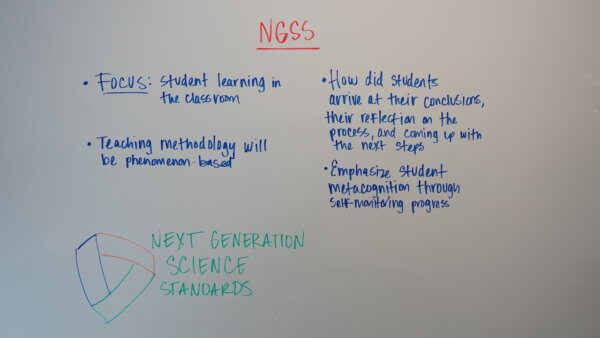What is NGSS Anyway?
https://youtu.be/h8uVoS-lBK8
Presented by Mark Adato – Transcription Below
Introduction
Welcome to the “Illuminate Whiteboard Series.” My name is Mark Adato. I’m an Implementation Manager on the D and A team, and today, we’re talking about the next generation science standards, also known as NGSS. So let’s talk about these standards that science teachers all over the country have been getting really worked up about lately. About 14 states have already adopted NGSS as their state science standards, and a few more are on the way real soon. Now, the emphasis for NGSS is less on the assessment that’s gonna happen afterwards, and more on the student learning in the classroom. So they really want to focus on what is happening instructionally, and how are students using the scientific process and the engineering design process to tackle problems in real-world scenarios? The emphasis for instruction is gonna be on teaching methodology that is phenomenon-based.
Not What You’re Used To
Now, this is gonna be a different take from what science teachers are normally used to. With phenomenon-based learning you would have, let’s say, different science experiments set up around the room, and have your students go around to each of them, and have them explain, “What do I think is happening here?” They don’t necessarily have to have any background in the material. They don’t necessarily have to have learned about it before. What we’re emphasizing is, “What do you think is happening?” and more importantly, “How could you figure it out? What kind of questions could you ask to figure out what is happening?” So for example, I might have a station showing the different water levels over the last couple of years, or maybe over the last couple of decades, and say, “Hey, what’s happening to the water levels, why do you think it’s happening, and what could you do to find out more about it?”
How It Works
In another station I might have a light bulb attached to a circuit in parallel and a circuit in series, and say, “Hey, try out lighting the light bulb with the two different types of circuits and see what happens, and tell me why, and tell me what we could do about it to make the light bulb shine brighter or shine less bright,” that sort of thing. So it focuses less on, “What is the right answer to the question?” and more on, “How did you get to the questions in the first place? How did you arrive at the conclusions that you did?” So there’s gonna be a lot of emphasis on the scientific inquiry process, there’s gonna be a lot of emphasis on engineering design, and a lot less on, “What should the correct answer be?”
The Big Questions
We’re gonna be asking students to metacognate, to think through what steps they are taking. Like, if I am running an experiment to find out, “How do I get that light bulb to burn a little bit brighter?” I’m gonna ask them, “Well, what were you thinking about before you set up the experiment? What types of control variables were you setting in place? Why were those important? How could you replicate this process with another type of experiment? Could you use this in the scenario where looking at different water levels over the last couple of decades and what are the connections between those two different types of processes?”
Conclusion
So NGSS is a departure from what science teachers have been using traditionally, for the most part, but if you are using inquiry-based learning, or if you are used to letting your kids try things out and explore the different areas of science without necessarily saying, “This is the right answer and this is where you’re supposed to land,” then you’re gonna be well-geared for the NGSS standards as soon as they get rolled out in your state.
Join us again for another Illuminate live web series. Again, my name is Mark Adato with Illuminate Education.
Whiteboard Image –

*****
Illuminate Education is a provider of educational technology and services offering innovative data, assessment and student information solutions. Serving K-12 schools, our cloud-based software and services currently assist more than 1,600 school districts in promoting student achievement and success.
Ready to discover your one-stop shop for your district’s educational needs? Let’s talk.

